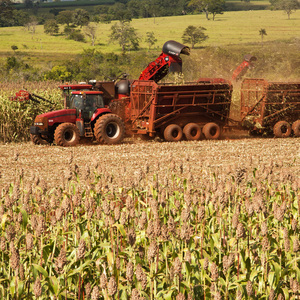Ceres reports Q3 results, provides update on operations in Brazil

Ceres Inc.
July 15, 2014
BY Erin Krueger
Ceres Inc. has released its fiscal third quarter 2014 financial results, reporting revenue of $800,000 for the three months ended May 31. The company also announced progress with its sorghum evaluations in Brazil.
When compared to the same quarter of last years, Ceres reported a $500,000 decrease in revenue. Collaborative research and government grant revenue decreased by $300,000. Production sales decreased by $200,000 million, primarily due to reduce biomass sales, which resulted from changes and reductions in the company’s sales incentive and promotional programs for the 2013-2014 growing season in Brazil.
Ceres reported a net loss of $7.7 million, or 17 cents per share, for the quarter. During the same period of last year, the company reported a net loss of $9.3 million, or 38 cents per share.
Advertisement
Advertisement
During a call to discuss the quarterly results, Richard Hamilton, president and CEO of Ceres, noted that the company met or exceeded its yield targets with multiple products in several regions of Brazil for both its sweet sorghum and high biomass sorghum seed products. He also announced that Ceres has been selected by the Brazilian government to receive a multi-million dollar grant and access to a multi-million dollar credit facility at government subsidized rates to pursue product opportunities in sorghum and sugarcane. In addition, Hamilton highlighted the recent addition of Bayer CropScience to its list of customers for the Persephone genome viewer software.
Regarding the company’s field evaluations in Brazil, Hamilton specified Ceres is current pursuing two markets for its sorghum hybrids. The company is targeting the ethanol market for its sweet sorghum products as a complement to sugarcane. Ceres is also targeting the power market for its high biomass sorghum hybrids. “Our primary goals this season were to improve execution in the field, increase yields and identify one or more hybrids in each region that met the expected yield range of our customers,” Hamilton said, noting that those goals were met.
According to Hamilton, Ceres high biomass sorghum performed well in several regions of Brazil. Several products met or exceeded levels the company believes are necessary for commercialization, he said, with top yields exceeding 35 metric tons per acre as measured at 50 percent moisture content. The sweet sorghum hybrids also showed encouraging results. “Calculated ethanol yields per hectare were approximately 35 percent higher on average than last year,” Hamilton said, noting that ethanol yields across 40 customer evaluation sits ranged from 950 liter per hectare to 4,200 liters per hectare, according to the company’s calculation. Hamilton also pointed out that 70 percent of customer locations achieves ethanol yields higher than 2,500 liters per acre with one or more products.
For the company’s elite hybrid evaluations, which Hamilton explained are the last set of internal evaluations before the company begins trialing a product in front of customers, ethanol yields from top experimental sweet sorghum products exceeded 5,000 liters per hectare, while other hybrids at earlier stages of product development demonstrated yields higher than 6,000 liters per hectare. According to Hamilton, experimental high biomass sorghum hybrids achieved yields of more than 50 metric tons of biomass per hectare, measured at a 50 percent moisture content. Ceres is expected to commercialize several new sorghum products next season and advance new hybrids into the product development pipeline.
Advertisement
Advertisement
Hamilton also highlighted a policy victory the company has achieved in Brazil. Working with Syngenta, the company achieved what is called a minor crop designation for sorghum under Brazilian regulations. According to Hamilton, that designation simplifies the registration process for crop protection products like herbicides and fungicides and makes it easier, quicker and cheaper for companies like Syngenta to introduce new products for Sorghum.
Related Stories
The U.S. EPA on July 8 hosted virtual public hearing to gather input on the agency’s recently released proposed rule to set 2026 and 2027 RFS RVOs. Members of the biofuel industry were among those to offer testimony during the event.
The USDA’s Risk Management Agency is implementing multiple changes to the Camelina pilot insurance program for the 2026 and succeeding crop years. The changes will expand coverage options and provide greater flexibility for producers.
EcoCeres Inc. has signed a multi-year agreement to supply British Airways with sustainable aviation fuel (SAF). The fuel will be produced from 100% waste-based biomass feedstock, such as used cooking oil (UCO).
The USDA’s National Agricultural Statistics Service on June 30 released its annual Acreage report, estimating that 83.4 million acres of soybeans have been planted in the U.S. this year, down 4% when compared to 2024.
SAF Magazine and the Commercial Aviation Alternative Fuels Initiative announced the preliminary agenda for the North American SAF Conference and Expo, being held Sept. 22-24 at the Minneapolis Convention Center in Minneapolis, Minnesota.
Upcoming Events










